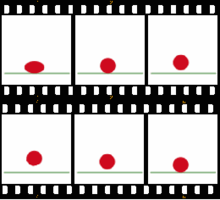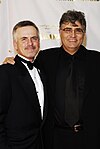Portal:Animation

| Main | Categories and topics | Tasks and projects |
Introduction
Animation is a filmmaking technique by which still images are manipulated to create moving images. In traditional animation, images are drawn or painted by hand on transparent celluloid sheets (cels) to be photographed and exhibited on film. Animation has been recognized as an artistic medium, specifically within the entertainment industry. Many animations are computer animations made with computer-generated imagery (CGI). Stop motion animation, in particular claymation, has continued to exist alongside these other forms.
Animation is contrasted with live-action film, although the two do not exist in isolation. Many moviemakers have produced films that are a hybrid of the two. As CGI increasingly approximates photographic imagery, filmmakers can easily composite 3D animations into their film rather than using practical effects for showy visual effects (VFX). (Full article...)
Selected article
Steven Spielberg Presents Animaniacs is an American animated television series, distributed by Warner Bros. and produced by Amblin Entertainment. The cartoon was the second animated series produced by the collaboration of Steven Spielberg (pictured) and Warner Bros. Animation during the animation renaissance of the late 1980s and early 1990s. The studio's first series, Tiny Toon Adventures, was a success among younger viewers, and a series that attracted a sizable number of adult viewers. The Animaniacs writers and animators, led by senior producer Tom Ruegger, used the experience gained from the previous series to create new animated characters that were cast in the mold of Chuck Jones and Tex Avery's creations. Animaniacs first aired on "FOX Kids" from 1993 until 1995 and later appeared on The WB from 1995 to 1998 as part of its "Kids' WB" afternoon programming block. The series had a total of 99 episodes and one film, titled Wakko's Wish. Like other animated series, it continued to appear on television through syndication long after its original airdate.
Selected image
Did you know (auto-generated) -

- ... that the French animated film The Summit of the Gods is based on a Japanese manga series?
- ... that the live-action comedy series Community had a stop motion animated Christmas special?
- ... that the creators of the cartoon Jade Armor filmed live-action martial arts stunts to visualize the show's animated action sequences?
- ... that the Tuca & Bertie episode "The Jelly Lakes" employs a paper-cutout animation that helps to depict abuse in a way that centers the victim's story?
- ... that according to an elaborate 1990s joke, Elmo Aardvark was history's first animated cartoon character?
- ... that Raoul Servais invented a new technique for combining animation and live action for his short film Harpya?
Selected quote
Selected biography
Ralph Bakshi (born October 29, 1938) is an American director of animated and, occasionally, live-action films. As the American animation industry fell into decline during the 1960s and 1970s, Bakshi tried to bring a change in the industry by establishing an alternative to mainstream animation in independent and adult-oriented productions. From 1972 until 1994, he directed nine theatrically-released feature films, writing five of them, and oversaw ten television projects as a director, producer and animator. Beginning his career at the Terrytoons television cartoon studio as a cel polisher, Bakshi was eventually promoted to director. He moved to the animation division of Paramount Pictures in 1967 and started his own studio, Bakshi Productions, in 1968. Through producer Steve Krantz, Bakshi made his debut feature film, Fritz the Cat, released in 1972. It was the first animated film to receive an X rating from the Motion Picture Association of America, and the most successful independent animated feature of all time.
Selected list
The Annie Award for Best Animated Home Entertainment Production is awarded annually by ASIFA-Hollywood, a non-profit organization that honors contributions to animation, to the best animated direct-to-video film of the year. It is one of the Annie Awards, which honor contributions to animation, including but not limited to producers, directors, and voice actors. The Annie Award for Best Animated Home Entertainment Production was created in 1995, and has been awarded yearly since. It was originally known as the Annie Award for Best Animated Video Production; the name of the award was changed in 1997 to the Annie Award for Best Home Video Production, was changed again in 1998 to the Annie Award for Outstanding Achievement in an Animated Home Video Production, and was changed in 2002 to the current name. To be eligible for the award, the film must have been released in the year before the next Annie Awards ceremony, and the developers of the game must send a five minute sample DVD of the film to a committee appointed by the Board of Directors of ASIFA-Hollywood.
More did you know...
- ...that the animated short film Sex Life of Robots, showing sexual activity among robots, is described as "art-porn"?
- ...that the donkey character Rucio in the 2007 children's film Donkey Xote, executive-produced by Giulia Marletta (pictured), was made to look like "Donkey" from Shrek?
- ...that Ed, Edd n Eddy's TV movie series finale, Ed, Edd n Eddy's Big Picture Show, premiered on November 8, 2009, and achieved high ratings success for Cartoon Network?
Anniversaries for May 12
- Films released
- 1932 - Mickey's Revue (United States)
- 1951 - Early to Bet (United States)
- 1962 - Mexican Boarders (United States)
Subportals
Related portals
Wikimedia
The following Wikimedia Foundation sister projects provide more on this subject:
-
Commons
Free media repository -
Wikibooks
Free textbooks and manuals -
Wikidata
Free knowledge base -
Wikinews
Free-content news -
Wikiquote
Collection of quotations -
Wikisource
Free-content library -
Wikiversity
Free learning tools -
Wiktionary
Dictionary and thesaurus



























